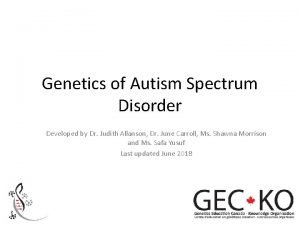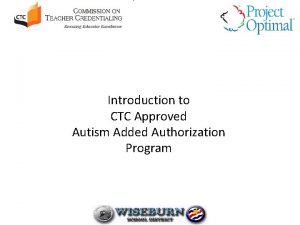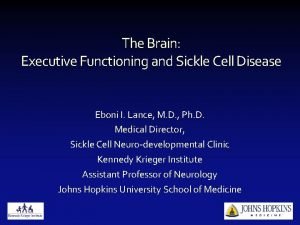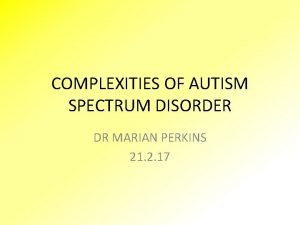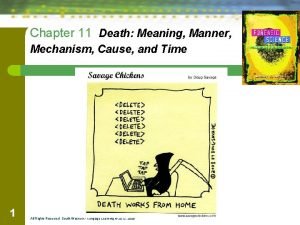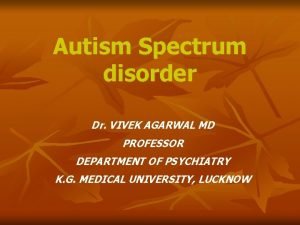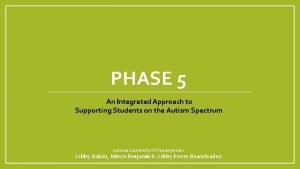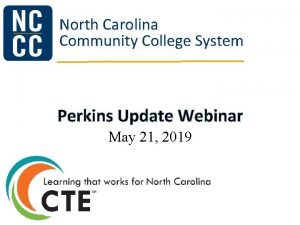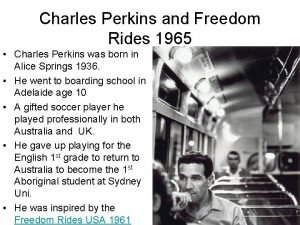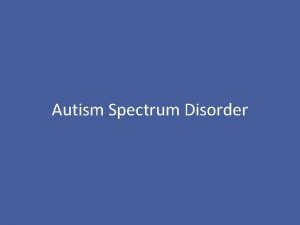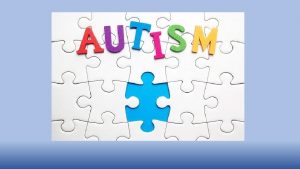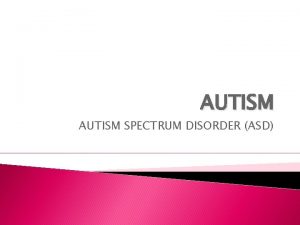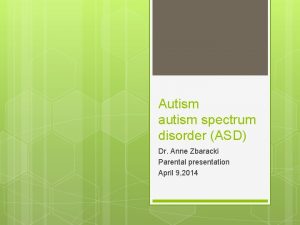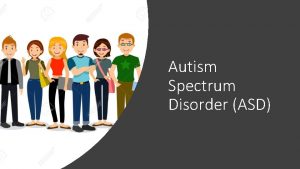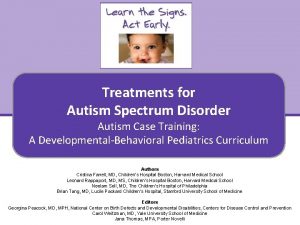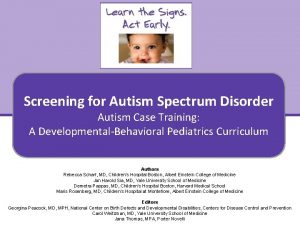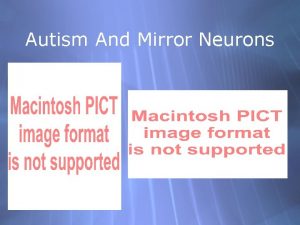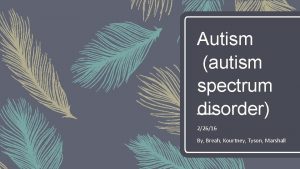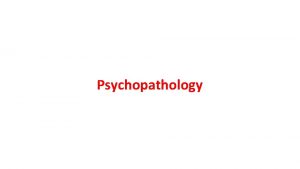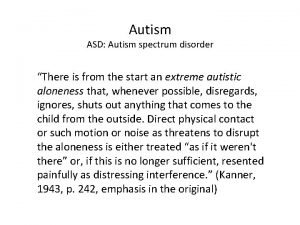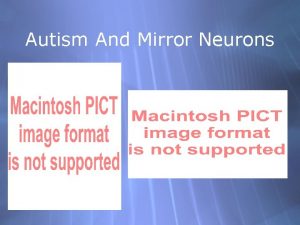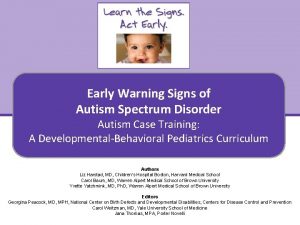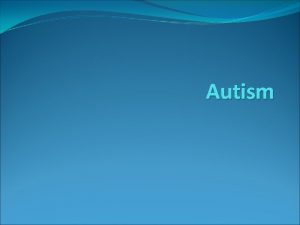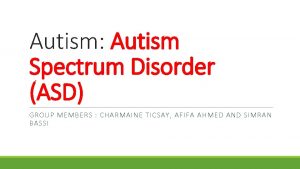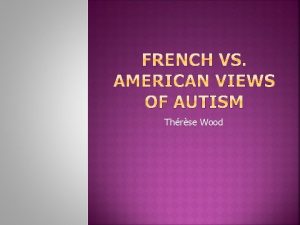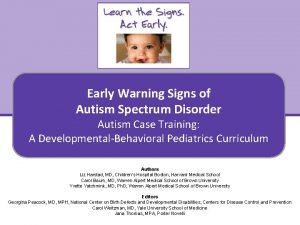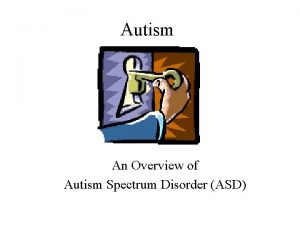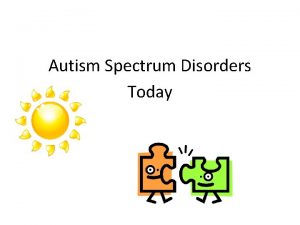COMPLEXITIES OF AUTISM SPECTRUM DISORDER DR MARIAN PERKINS






















- Slides: 22

COMPLEXITIES OF AUTISM SPECTRUM DISORDER DR MARIAN PERKINS 21. 2. 17

OVERVIEW • Specialist Outpatient Neuropsychiatric Service in Oxon • Diagnostic Challenges • Complex Presentations • Treatments • Pharmacotherapy

AUTISM SPECTRUM DISORDER • Neurodevelopmental condition defined by number of behavioural features • DSM-5 (May 2013) impairments in areas of functioning; social communication and social interaction as well as restricted, repetitive patterns of behaviour, interests or activities • Symptoms present in early developmental period BUT may not fully manifest until social demands exceed the child’s limited capacities OR may be masked by learned strategies in later life • Autism constitutes a spectrum, as now depicted in term in DSM-5 of Autism Spectrum Disorder (ASD), with a range of severity levels and support needs • Not explained better by intellectual disability or global developmental delay • Includes what was labelled in pervious classification as Autism and Aspergers Disorder • ICD-11 expected to be approved by WHO in 2015; seems to incorporate similar modifications to those in DSM-5

SOCIAL (PRAGMATIC) COMMUNICATION DISORDER • New category, separate from ASD • Controversial • From early childhood, difficulty with each of these features: • Using language for social reasons • Adapting communication to fit the context • Following the conventions (rules) of conversation • Understanding implied communications • Consider work/educational or personal impairment • Usually identified by 4 -5 years of age

PATHOLOGICAL DEMAND AVOIDANCE 1. Passive early history in first year 2. Continues to resist and avoid ordinary demands of life 3. Surface sociability, but apparent lack of sense of social identity, pride or shame 4. Lability of mood, impulsive, led by need to control 5. Comfortable in role play and pretending 6. Language delay, seems result of passivity 7. Obsessive behaviour 8. Neurological involvement

DIFFERENTIAL DIAGNOSIS • • Other Pervasive Developmental Disorders Rett’s Syndrome Childhood Disintegrative Disorder Receptive-Expressive Language Disorders Landau – Kleffner Syndrome Intellectual Disability Sensory Deficits Emotional Neglect

NEURODEVELOPMENTAL PROBLEMS AND DISORDERS • Global delay or intellectual disability • Motor co-ordination problems or DCD • Academic learning problems, for example, in numeracy or literacy • Speech and Language Disorder

ASD AND MEDICAL CONDITIONS • • Intellectual disability (8% - 27. 9%) Fragile X syndrome (24% - 60%) Tuberous Sclerosis (36% - 79%) Neonatal encephalopathy/epileptic encephalopathy/infantile spasms (4% - 14%) Cerebral Palsy (15%) Down Syndrome (6%-15%) Muscular Dystrophy (3% - 37%) Neurofibromatosis (4% - 8%)

CO-MORBIDITIES • • • ADHD Mood Disorders Gilles de la Tourette's Syndrome Sleep Disorders OCD

ASD DIAGNOSIS? • Females with ASD (n=40) 80% Axis 1 diagnoses (mood=65%, anxiety=55%, ADHD=43%, OCD=33%, ED=10% psychotic disorders=5% Hofvander B 2009 • Co-morbidity of young adults with Aspergers Syndrome – 70% major depression, 50% recurrent depressive disorder, 50% anxiety disorders Lugnegard 2011 • 94% of C+A with Asperger Syndrome have at least one psychiatric disorder: Anxiety (54%), Behavioural (48%), Mood (37%) Mukaddes 2010 • Pathway to adult ASD – Most common earlier diagnoses are anxiety, mood or psychosis related disorders. More common in females Geurts 2011

COMPLEX DIFFERING PRESENTATIONS • In non clinical sample questionnaire measures of Aspergers Syndrome and Schizotypal Personality Disorder positively correlated Hurst 2007 • Relationship between ASD and schizophrenia – Over 15 year period 26 pts newly diagnosed with ASD. 22 had co-morbid psychotic symptoms (16 schizophrenia, 6 mood disorder) Raja 2010 • Adolescents and adults with ASD significantly more likely to show inappropriate courting behaviours – focus attention on celebrities, strangers, colleagues and ex-partners and pursue target longer Stokes 2007 • • • Attachment issues Eating disorders Females Gender identity Adult presentations

ASD IN FEMALES • Fewer and qualitatively different repetitive behaviours • Equivalent levels of social communication difficulties • Less obvious difficulties with socialising and behaviour regulations at school – but NOT at home • Higher levels of internalising difficulties

SOME CLINICAL HYPOTHESES • More likely to be misunderstood and misdiagnosed at initial presentation to services • More subtle social difficulties and possibility to mask difficulties better than boys • More social motivated, more often aware of “what is lacking” • More skilled in one-to-one interactions than boys, may be protected by a single friendship

GENDER DYSPHORIA AND AUTISM SPECTRUM DISORDER • Incongruence between assigned and experienced gender • Growing clinical recognition that a significant proportion of patients with gender dysphoria have concurrent ASD • Very limited data and research (especially in adults) • Dr Vries (2010) sample referred to gender identity clinic in Netherlands; higher prevalence of ASD than in general population

IDENTIFYING TARGETS FOR INTERVENTION Identify most problematic behaviour Are these realistic to treat? Elicit antecedents and consequences Link behaviours to relevant psychiatric symptoms/disorders • Draw on available evidence base to initiate treatment • •

INTERVENTIONS • Behaviourally based – Improve parent-child interactions – Developing social and communication skills • • • Educationally based Accessible community support Psychological approaches eg; CBT Pharmacotherapy On-line

PRINCIPLES FOR INTERVENTION • • Individualisation Structure Intensity and generalization Family participation

PROBLEMS PSYCHOPHARMACOLOGY INTERVENTIONS IN ASD • Challenges of differential diagnosis • Multiple symptoms make target for intervention to difficult to select and monitor for outcome • More prone to adverse effects • Difficult to elicit account of symptoms/target and adverse side effects from child/person • Lack evidence base in this population

TARGETS OF TREATMENT Core Symptoms • Social Reciprocity • Communication • Rigidity, Stereotypies Other Symptoms • ADHD like symptoms • Aggression • Anxiety • Irritability, affective instability • Negativism • Sleep

TYPES OF DRUGS • • • Neuroleptics SSRIs Methylphenidate Melatonin Naltrexone Others

CLINICAL GUIDELINES FOR PHARMACOTHERAPY IN AUTISM (1) Target Medications • Hyperactivity Methylphenidate or other stimulants Atomoxetine Atypical antipsychotics Clonidine • Rigidity, rituals Selective Serotonin Reuptake inhibitors Atypical antipsychotics

CLINICAL GUIDELINES FOR PHARMACOTHERAPY IN AUTISM (2) Target Aggression, Self-injury Medications Atypical Antipsychotics Lithium B Blockers Anticonvulsants Clonidine Anxiety, affective Symptoms Clonidine Buspirone Atypical antipsychotics Sleep Disturbance Melatonin SSRIs – Fluoxetine Mood stabilisers
 Types of autism spectrum disorder
Types of autism spectrum disorder Is autism genetic
Is autism genetic Autism spectrum disorders added authorization
Autism spectrum disorders added authorization Autism spectrum disorder adhd
Autism spectrum disorder adhd Sensory processing disorder dsm
Sensory processing disorder dsm Qualities behaviors and complexities
Qualities behaviors and complexities Social pragmatic communication disorder
Social pragmatic communication disorder Puberty and autism spectrum disorders
Puberty and autism spectrum disorders Conversion vs somatic symptom disorder
Conversion vs somatic symptom disorder Fetal alcohol spectrum disorder
Fetal alcohol spectrum disorder Spectrum disorder
Spectrum disorder Spectrum disorder
Spectrum disorder Absorption spectrum vs emission spectrum
Absorption spectrum vs emission spectrum Explain electronic configuration of cu and cr
Explain electronic configuration of cu and cr Perkins geology museum
Perkins geology museum Cteig allowable expenses
Cteig allowable expenses Bag lunch by dillard perkins
Bag lunch by dillard perkins Nc perkins
Nc perkins Perkins 4008-30tag2 technical data
Perkins 4008-30tag2 technical data Lars perkins
Lars perkins Jens hilke
Jens hilke Introduction of the yellow wallpaper
Introduction of the yellow wallpaper Safa freedom rides
Safa freedom rides

